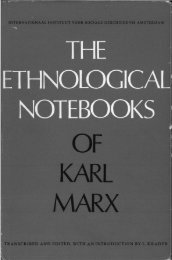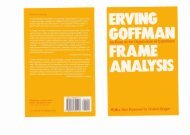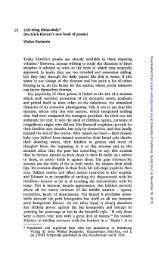- Page 2: The Cambridge Companion to Lacan Th
- Page 5 and 6: cambridge university press Cambridg
- Page 7 and 8: contents 9 Lacan’s Marxism, Marxi
- Page 9 and 10: notes on the contributors Than They
- Page 12 and 13: PREFACE After Freud, Lacan is argua
- Page 16 and 17: Preface Indeed, by a curious twist,
- Page 18 and 19: ABBREVIATIONS Note: English transla
- Page 20 and 21: CHRONOLOGY OF LACAN’S LIFE 1901 1
- Page 22 and 23: chronology 1931 18 June Lacan exami
- Page 24 and 25: chronology luminaries include Danie
- Page 26 and 27: chronology 1961 August A progressiv
- Page 28 and 29: chronology 1973 Publication of Semi
- Page 30 and 31: 1 JEAN-MICHEL RABAT É Lacan’s tu
- Page 32 and 33: Lacan’s turn to Freud in which Fr
- Page 34 and 35: Lacan’s turn to Freud Actéon tro
- Page 36 and 37: Lacan’s turn to Freud fisherman
- Page 38 and 39: Lacan’s turn to Freud Foucault ma
- Page 40 and 41: Lacan’s turn to Freud my commenta
- Page 42 and 43: Lacan’s turn to Freud actress was
- Page 44 and 45: Lacan’s turn to Freud (PP,p.309 n
- Page 46 and 47: Lacan’s turn to Freud granting ac
- Page 48 and 49: Lacan’s turn to Freud Dalí’s i
- Page 50 and 51: Lacan’s turn to Freud cannot stri
- Page 52 and 53: Lacan’s turn to Freud 9. Lacan, E
- Page 54 and 55: 2 ELISABETH ROUDINESCO The mirror s
- Page 56 and 57: The mirror stage: an obliterated ar
- Page 58 and 59: The mirror stage: an obliterated ar
- Page 60 and 61: The mirror stage: an obliterated ar
- Page 62 and 63: The mirror stage: an obliterated ar
- Page 64 and 65:
3 DARIAN LEADER Lacan’s myths Fre
- Page 66 and 67:
Lacan’s myths the separation is m
- Page 68 and 69:
Lacan’s myths This crucial step o
- Page 70 and 71:
Lacan’s myths friend. “This pha
- Page 72 and 73:
Lacan’s myths prime example of su
- Page 74 and 75:
Lacan’s myths Seminar on Transfer
- Page 76 and 77:
Lacan’s myths discussion of the l
- Page 78 and 79:
Lacan’s myths NOTES 1. Sigmund Fr
- Page 80 and 81:
Lacan’s science of the subject sy
- Page 82 and 83:
Lacan’s science of the subject (E
- Page 84 and 85:
Lacan’s science of the subject in
- Page 86 and 87:
Lacan’s science of the subject it
- Page 88 and 89:
Lacan’s science of the subject La
- Page 90 and 91:
Lacan’s science of the subject ap
- Page 92 and 93:
Lacan’s science of the subject ps
- Page 94 and 95:
Lacan’s science of the subject a
- Page 96 and 97:
Lacan’s science of the subject in
- Page 98 and 99:
5 BERNARD BURGOYNE From the letter
- Page 100 and 101:
From the letter to the matheme stru
- Page 102 and 103:
From the letter to the matheme prob
- Page 104 and 105:
From the letter to the matheme use
- Page 106 and 107:
From the letter to the matheme Koyr
- Page 108 and 109:
From the letter to the matheme Brun
- Page 110 and 111:
From the letter to the matheme orie
- Page 112 and 113:
From the letter to the matheme he i
- Page 114 and 115:
From the letter to the matheme 19.
- Page 116 and 117:
The paradoxes of the symptom in psy
- Page 118 and 119:
The paradoxes of the symptom in psy
- Page 120 and 121:
The paradoxes of the symptom in psy
- Page 122 and 123:
The paradoxes of the symptom in psy
- Page 124 and 125:
The paradoxes of the symptom in psy
- Page 126 and 127:
The paradoxes of the symptom in psy
- Page 128 and 129:
The paradoxes of the symptom in psy
- Page 130 and 131:
The paradoxes of the symptom in psy
- Page 132 and 133:
Desire and jouissance in the teachi
- Page 134 and 135:
Desire and jouissance in the teachi
- Page 136 and 137:
Desire and jouissance in the teachi
- Page 138 and 139:
Desire and jouissance in the teachi
- Page 140 and 141:
Desire and jouissance in the teachi
- Page 142 and 143:
Desire and jouissance in the teachi
- Page 144 and 145:
Desire and jouissance in the teachi
- Page 146 and 147:
Lacan and philosophy where the “c
- Page 148 and 149:
Lacan and philosophy any more than
- Page 150 and 151:
Lacan and philosophy as a signifier
- Page 152 and 153:
Lacan and philosophy Lacan’s trea
- Page 154 and 155:
Lacan and philosophy This conceptua
- Page 156 and 157:
Lacan and philosophy philosophy and
- Page 158 and 159:
Lacan and philosophy but to the act
- Page 160 and 161:
Lacan and philosophy In short, from
- Page 162 and 163:
Lacan and philosophy about ethnicit
- Page 164 and 165:
Lacan and philosophy nevertheless s
- Page 166 and 167:
Lacan and philosophy of every epoch
- Page 168 and 169:
Lacan and philosophy While the “m
- Page 170 and 171:
Lacan and philosophy experiences, f
- Page 172 and 173:
Lacan and philosophy exists (and we
- Page 174 and 175:
Lacan and philosophy necessary impo
- Page 176 and 177:
Lacan and philosophy our normal dis
- Page 178 and 179:
Lacan and philosophy 8. Heidegger
- Page 180 and 181:
Lacan and philosophy what becomes o
- Page 182 and 183:
9 JOSEPH VALENTE Lacan’s Marxism,
- Page 184 and 185:
Lacan’s Marxism, Marxism’s Laca
- Page 186 and 187:
Lacan’s Marxism, Marxism’s Laca
- Page 188 and 189:
Lacan’s Marxism, Marxism’s Laca
- Page 190 and 191:
Lacan’s Marxism, Marxism’s Laca
- Page 192 and 193:
Lacan’s Marxism, Marxism’s Laca
- Page 194 and 195:
Lacan’s Marxism, Marxism’s Laca
- Page 196 and 197:
Lacan’s Marxism, Marxism’s Laca
- Page 198 and 199:
Lacan’s Marxism, Marxism’s Laca
- Page 200 and 201:
Lacan’s Marxism, Marxism’s Laca
- Page 202 and 203:
10 ALENKA ZUPAN ČIČ Ethics and tr
- Page 204 and 205:
Ethics and tragedy in Lacan Oedipus
- Page 206 and 207:
Ethics and tragedy in Lacan that th
- Page 208 and 209:
Ethics and tragedy in Lacan Psychoa
- Page 210 and 211:
Ethics and tragedy in Lacan part in
- Page 212 and 213:
Ethics and tragedy in Lacan lifting
- Page 214 and 215:
Ethics and tragedy in Lacan In the
- Page 216 and 217:
Ethics and tragedy in Lacan heroine
- Page 218 and 219:
Ethics and tragedy in Lacan to thos
- Page 220 and 221:
11 JUDITH FEHER-GUREWICH A Lacanian
- Page 222 and 223:
A Lacanian approach to the logic of
- Page 224 and 225:
A Lacanian approach to the logic of
- Page 226 and 227:
A Lacanian approach to the logic of
- Page 228 and 229:
A Lacanian approach to the logic of
- Page 230 and 231:
A Lacanian approach to the logic of
- Page 232 and 233:
A Lacanian approach to the logic of
- Page 234 and 235:
A Lacanian approach to the logic of
- Page 236 and 237:
A Lacanian approach to the logic of
- Page 238 and 239:
What is a Lacanian clinic? conceptu
- Page 240 and 241:
What is a Lacanian clinic? never pu
- Page 242 and 243:
What is a Lacanian clinic? A simple
- Page 244 and 245:
What is a Lacanian clinic? ripe), a
- Page 246 and 247:
What is a Lacanian clinic? Neurosis
- Page 248 and 249:
What is a Lacanian clinic? emptied
- Page 250 and 251:
13 DEBORAH LUEPNITZ Beyond the phal
- Page 252 and 253:
Beyond the phallus: Lacan and femin
- Page 254 and 255:
Beyond the phallus: Lacan and femin
- Page 256 and 257:
Beyond the phallus: Lacan and femin
- Page 258 and 259:
Beyond the phallus: Lacan and femin
- Page 260 and 261:
Beyond the phallus: Lacan and femin
- Page 262 and 263:
Beyond the phallus: Lacan and femin
- Page 264 and 265:
Beyond the phallus: Lacan and femin
- Page 266 and 267:
Beyond the phallus: Lacan and femin
- Page 268 and 269:
Lacan and queer theory calls biopow
- Page 270 and 271:
Lacan and queer theory how we think
- Page 272 and 273:
Lacan and queer theory not be appre
- Page 274 and 275:
Lacan and queer theory impasses. In
- Page 276 and 277:
Lacan and queer theory it represent
- Page 278 and 279:
Lacan and queer theory distinction
- Page 280 and 281:
Lacan and queer theory with the dea
- Page 282 and 283:
15 CATHERINE LIU Lacan’s afterlif
- Page 284 and 285:
Lacan’s afterlife: Jacques Lacan
- Page 286 and 287:
Lacan’s afterlife: Jacques Lacan
- Page 288 and 289:
Lacan’s afterlife: Jacques Lacan
- Page 290 and 291:
Lacan’s afterlife: Jacques Lacan
- Page 292 and 293:
Lacan’s afterlife: Jacques Lacan
- Page 294 and 295:
Lacan’s afterlife: Jacques Lacan
- Page 296 and 297:
Lacan’s afterlife: Jacques Lacan
- Page 298 and 299:
Lacan’s afterlife: Jacques Lacan
- Page 300 and 301:
Lacan’s afterlife: Jacques Lacan
- Page 302 and 303:
further reading (1955) Seminar on
- Page 304 and 305:
further reading Thésaurus Lacan: N
- Page 306 and 307:
further reading Copjec, Joan, Read
- Page 308 and 309:
further reading Leupin, Alexandre,
- Page 310 and 311:
further reading Sullivan, Henry W.,
- Page 312 and 313:
castration 110-11, 113, 123-4, 136-
- Page 314 and 315:
Levinas, E. 148 Lévi-Strauss, C. x
- Page 316 and 317:
Whitehead, A. N 78, 143 Whiteread,
- Page 318 and 319:
The Cambridge Companion to Tolstoy







